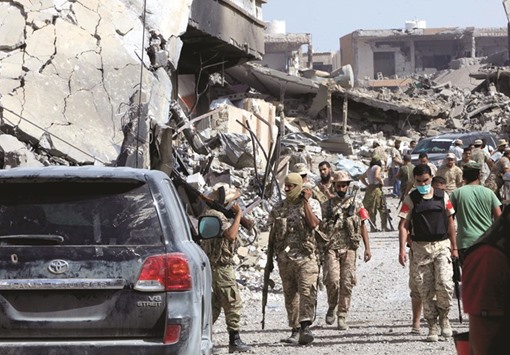The Islamic State group’s beleaguered Libyan stronghold of Sirte has been devastated by months of fighting, the second time in five years it has been wrecked.
Tanks roar through rubble-strewn streets while explosions and gunfire rock gutted buildings.
Most of the 120,000 residents have fled, either in fear of militants or forced out by pro-government forces who have been battling since May to oust IS from what was once its north African headquarters.
The 2011 uprising that toppled its most famous son, the late dictator Muammar Gaddafi, laid waste to Sirte.
Residents rebuilt after the war, but this year’s fighting has once again left the coastal town in ruins.
Apart from fighters, Sirte is now a ghost town with no electricity or phone coverage within a hundred kilometres.
Pro-government Libyan forces backed by American air strikes are gradually tightening the noose on the few remaining IS fighters holed up in District Three in the east.
IS took over Sirte in June 2015, flying their black flags above public buildings and imprisoning, crucifying or beheading dozens of people.
Militants roamed the streets in pickup trucks to check that residents were praying at the correct times and that women did not leave home without a male minder.
Forces allied with Libya’s UN-backed and internationally recognised Government of National Unity (GNA) launched an offensive in May to oust IS from the city and surrounding areas.
They entered Sirte itself on June 9, and the militants hit back with suicide bombings and snipers.
More than 550 GNA fighters have been killed and 3,000 wounded in the assault.
Shop fronts throughout town still bear the black stamp of the “Office of General Services”, the militants’ tax authority.
On those walls that are still standing, slogans glorifying IS have been erased and replaced with “Bye bye Daesh” -- an Arabic acronym for IS.
Forces loyal to Libya’s unity government suspect that the militants had local help when they seized the town.
The loyalist forces expelled residents and were preventing them from returning to “liberated” areas, said Hadi, the commander of a group of fighters from Tripoli.
“We do not want to take risks by leaving a potential enemy behind our backs,” he said, adding that he had come to fight the militants and hoped “to die a martyr”.
While most members of the pro-government forces are from Misrata half way between Tripoli and Sirte, fighters have come from across Libya, he said.
For some of the GNA-allied fighters battling IS, the destruction of Sirte is justice.
“When we see the number of martyrs and wounded when we liberated Gaddafi’s home town in 2011 and again today, we can say the residents of Sirte deserved what they got,” said Mohamed, a fighter from Misrata.
Another fighter agreed.
“It’s war,” he said. “We can’t do anything about it, and they deserve what’s happening to them.”
It was in Sirte that Gaddafi fought his last battle before being killed on October 20, 2011 as he tried to flee.
Since then, the town has been like a “sheep among the wolves”, said a local official, who did not want to give his name because he feared for his safety.
He and his family fled Sirte a few months ago while it was still under full IS control.
“They want to punish us again, accusing us of welcoming Daesh with open arms, while in fact we were abandoned to our fate,” he said.
“After 2011, a new militia arrived in our town every month or two,” he said.
“We were unarmed and every time we had to submit to their authority. Finally it was Daesh that arrived.”
After 2011, residents began to rebuild, said Mohamed, a Sirte resident who has sought refuge in the capital Tripoli.
“There are people who had just finished rebuilding their houses. Now, suddenly, they’re destroyed again,” the father of three said.
“The worst thing is that after calling us Gaddafists, now they label us Daesh supporters,” he added.
“We can forget the destruction, the poverty and the hunger, but not the humiliation.
That will stay with us for life.”

Libyan forces allied with the UN-backed government gather after they captured a new area from Islamic State militants in Sirte, Libya, last week.
